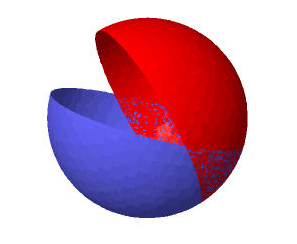Yashar Mermarian writes here that the answer is yes. And the argument he gives is pretty much the same as the one you already started.
Taking $n=k$ and $\epsilon=\pi/2$ Gromov's waist inequality gives a point $z\in \mathbb{R}^n$ such that $$vol(U_{\pi/2}(S_Z))\geq vol(U_{\pi/2}(S^0))=vol(U_{\pi/2}(\{(1,0,\dots,0),(-1,0,\dots,0)\})=vol(S^n).$$ It follows that $U_{\pi/2}(S_Z)$ has to have the same volume as the sphere. This can only be the case when $S_Z$ contains at least $2$ elements, since the volume of $U_\epsilon(S_Z)$ would be to small otherwise. If it contains $2$ elements and not more, these $2$ elements would have to be antipodal, otherwise the volume of $U_\epsilon(S_Z)$ would be to small again. Although Memarian writes there "is no choice" for $S_Z$ but to "pass through antipodal points", I don't really see how one can rule out that $S_Z$ might consist of more than two points. I hope someone can make this clear.
To summarize thisThis gives the following (weaker) version of a Bursuk Ulam type result:
If $f:\; S^n\to\mathbb{R}^n$ is continuous, then $f$ maps two antipodal points in $S^n$ to the same point in $\mathbb{R}^n$ or $f$ maps (at least) three points to the same point in $\mathbb{R}^n$.
 $U_{\pi/2}$ for two points which are not antipodal.
$U_{\pi/2}$ for two points which are not antipodal.
In the original paper Gromov is more careful. He writes:
If $k=n$, and $\operatorname{card}(f^{-1}(z))\leq 2$, $z\in\mathbb{R}^n$, then [the waist of the sphere theorem] applied to $\pi/2$ amounts to the Borsuk–Ulam theorem: some level $f^{-1}(z)$ of $f\;:S^n\to \mathbb{R}^k$ equals a pair of opposite points.
Of course $f^{-1}(z)$ is just a different notation of $S_Z$. So the important detail is: "and $\operatorname{card}(f^{-1}(z))\leq 2$".
In general $\operatorname{card}(f^{-1}(z))\leq 2$ is not true for arbitrary maps. And even if you perturbe $f$ a little bit this condition won't be fullfilled. Of course any two maps from $S^n$ to $\mathbb{R}^n$ are homotopic, so in particular $f$ will be homotopic to a map with $\operatorname{card}(f^{-1}(z))\leq 2$ for all $z$, but this doesn't really give you anything.
To summarize the answer is: Gromov's Waist Inequality almost implies Borsuk-Ulam.
